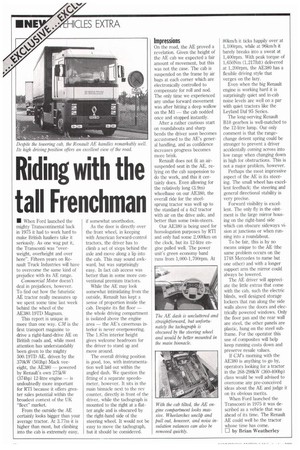Riding with the tall Frenchman
Page 14

If you've noticed an error in this article please click here to report it so we can fix it.
• When Ford launched the mighty Transcontinental back in 1975 it had to work hard to make British hauliers take it seriously. As one wag put it, the Transconti was "overweight, overheight and over here". Fifteen years on Renault Truck Industries will have to overcome the same kind of prejudice with its AE range.
Commercial Motor doesn't deal in prejudices, however. To find out how the futuristic AE tractor really measures up we spent some time last week behind the wheel of the AE380.19TD Magnum.
This report is unique in more than one way. CM is the first transport magazine to drive a right-hand-drive AE on British roads and, while most attention has understandably been given to the mighty 500.19TD AE, driven by the 370kW (503hp) Mack veeeight, the AE380 — powered by Renault's own 275kW (374hp) 12-litre engine — is undoubtedly more important for RT1 because it offers greater sales potential within the broadest context of the UK "fleet" market.
From the outside the AE certainly looks bigger than your average tractor. At 3.77m it is higher than most, but climbing into the cab is extremely easy, if somewhat unorthodox.
As the door is directly over the front wheel, in keeping with American forward-control tractors, the driver has to climb a set of steps behind the axle and move along a lip into the cab. This may sound awkward, but was surprisingly easy. In fact cab access was better than in some more conventional premium tractors.
While the AE may look somewhat intimidating ft-urn the outside, Renault has kept a sense of proportion inside the cab. Despite its flat floor — the whole driving compartment is isolated above the engine area — the AE's cavernous interior is never overpowering. The 1.87m interior height gives welcome headroom for the driver to stand up and move around.
The overall driving position is good, too, with instrumentation well laid out within the angled dash. We question the fitting of a separate speedometer, however. It sits in the main binnacle next to the rev counter, directly in front of the driver, while the tachograph is mounted to the right at a flatter angle and is obscured by the right-hand side of the steering wheel. It would not be easy to move the tachograph, but it should be considered.
Impressions
On the road, the AE proved a revelation. Given the height of the AE cab we expected a fair amount of movement, but this was not the case. The cab is suspended on the frame by air bags at each corner which are electronically controlled to compensate for roll and nod. The only time we experienced any undue forward movement was after hitting a deep wallow on the M1 — the cab nodded once and stopped instantly.
After a rather cautious start on roundabouts and sharp bends the driver soon becomes accustomed to the AE's general handling, and as confidence increases progress becomes more brisk.
Renault does not fit an airsuspended seat in the AE, relying on the cab suspension to do the work, and this it certainly does. Even allowing for the relatively long (3.9m) wheelbase on our AE380, the overall ride for the steelsprung tractor was well up to the standard of a 4x2 tractor with air on the drive axle, and better than some twin-steers.
Our AE380 is being used for homologation purposes by RTI and only had some 2,000km on the clock, but its 12-litre engine pulled well. The power unit's green economy band runs from 1,000-1,700rpm. At 80km/h it ticks happily over at 1,100rpm, while at 96knilh it barely breaks into a sweat at 1,400rpm. With peak torque of 1,650Nm (1,2171bft) delivered at 1,200rpm, the AE380 has a flexible driving style that verges on the lazy.
Even when the big Renault engine is working hard it is surprisingly quiet and in-cab noise levels are well on a par with quiet tractors like the Leyland Daf 95 Series.
The long-serving Renault B18 gearbox is well-matched to the 12-litre lump. Our only comment is that the rangechange detent spring could be stronger to prevent a driver accidentally coming across into low range when changing down in high for obstructions. This is not a major problem, however.
Perhaps the most impressive aspect of the AE is its steering. The small wheel has excellent feedback; the steering and general directional stability is very precise.
Forward visibility is excellent. The only fly in the ointment is the large mirror housing on the right-hand side which can obscure sideways vision at junctions or when running into a roundabout.
To be fair, this is by no means unique to the AE (the same problem occurs on the 1748 Mercedes to name but one other) and with a longer support arm the mirror could always be lowered.
The AE driver will appreciate the little extras that come with the cab, such the electric blinds, well designed storage lockers that run along the side walls above the doors and electrically powered windows. Only the floor pan and the rear wall are steel, the other panels are plastic, hung on the steel subframe. For the operator this use of composites will help keep running costs down and preserve resale values.
If CM's morning with the AE380 is anything to go by, operators looking for a tractor in the 268-298kW (360-400hp) class would be well advised to overcome any pre-conceived ideas about the AE and judge it on its obvious merits.
When Ford launched the Transconti in 1975 it was described as a vehicle that was ahead of its time. The Renault AE could well be the tractor whose time has come.
LI by Brian Weatherley




























































































































